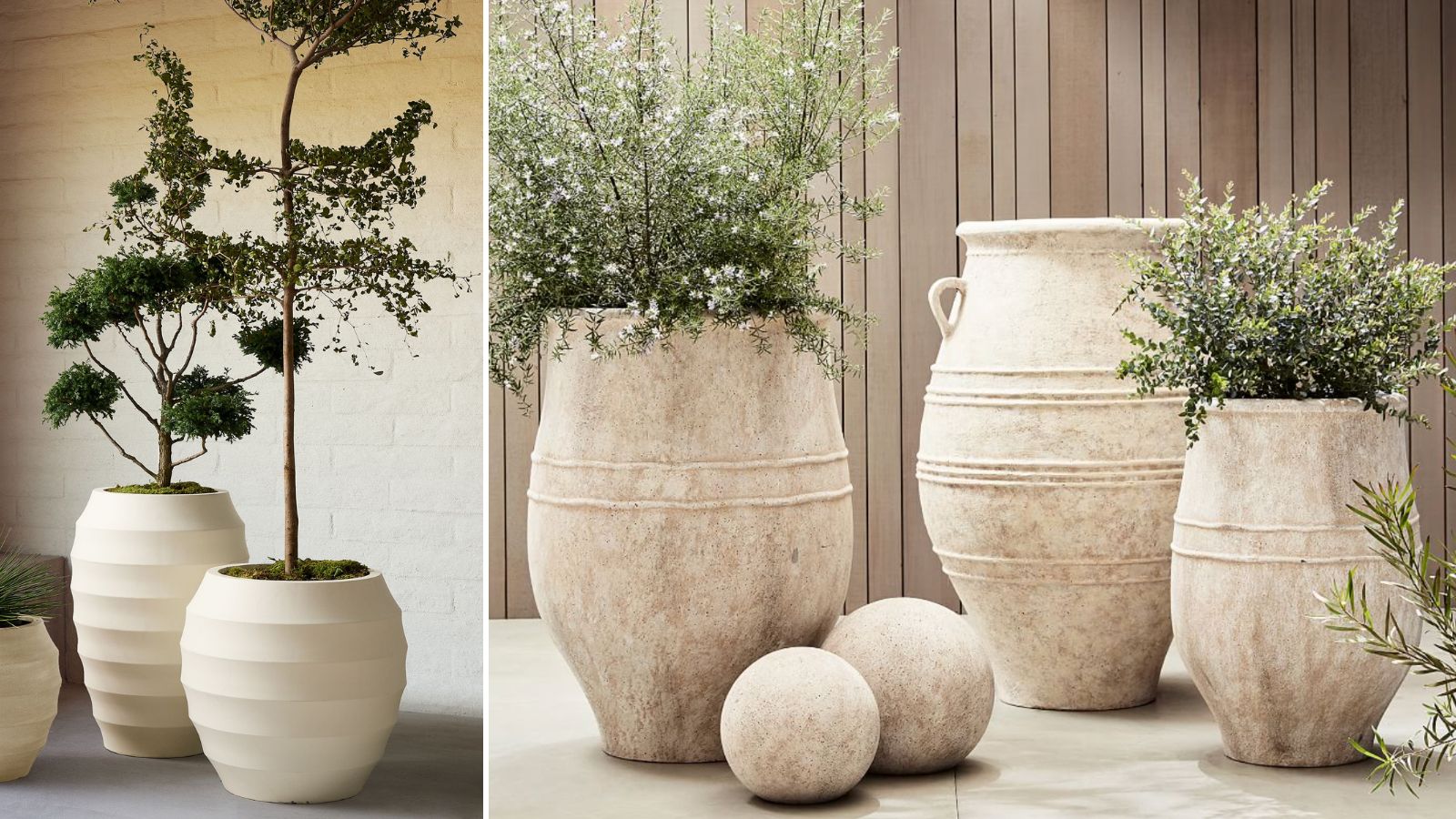Without a doubt, a large decorative pot or two will add much-needed curb appeal and elegant visual interest to your home. Whether your yard is spacious or compact, there’s always room to incorporate these eye-catching pieces – the key is knowing how to style them and what to plant inside. Large pots are extremely versatile, capable of holding everything from tall ornamental grasses to vibrant flowers or fruit trees, making them the perfect addition to your front yard landscaping .
Matching pots can frame a doorway, while a bold, oversized piece can create a dramatic centerpiece. But how do you know where to start when selecting and styling these garden accessories? To guide you through the process, we’ve gathered some creative ideas and expert tips for styling large, decorative pots in your front yard. Before you purchase a new decorative pot or container, take a moment to consider the space you’re working with.

Think about the size and layout of your front yard, and how the pots will fit into the existing landscape. If you have a small front yard, choosing the right size and style of pot is essential to avoid overwhelming the space – opt for sleek, compact designs that enhance your yard without crowding it. On the other hand, if you have a spacious front yard, don't be afraid to go big with oversized pots or groupings that create impactful focal point.
Decorative pots can make a striking statement on their own, but adding greenery and flowers can step up their impact. So, how do you go about styling your pots with the perfect plants? ‘A good guide for styling large decorative pots would be to select "thriller, filler, and spiller" plants,’ explains Kassi Kuppinger from Bath Garden Center: Kassi leads the marketing department at Bath Garden Center & Nursery, a small, family-owned business that has been serving Fort Collins and the surrounding area since 1965. They take a natural approach to plants and gardening supplies and offer everything from trees, shrubs, and perennials to houseplants, garden veggies, annual flowers, and more ‘It's useful to think of large pots as architectural features themselves; they can set off features like pillars or windows, and they're great for separating spaces like walking paths from the rest of the yard,’ says Rafi Friedman , President of Coastal Luxury Outdoors.
‘With this in mind, placement is key, and you should strive to choose pots whose style and color match that of your home.’ When selecting pots for focal points, consider their design impact. Bold colors, unique shapes, or intricate patterns can draw the eye and create a visual anchor in your yard.
For example, a particularly tall pot with a minimalist design can enhance the clean lines of a contemporary home. It's also important to think about the scale of your pots relative to their surroundings. Large pots should complement, rather than overwhelm, the existing architecture and landscaping.
To maintain balance, pair oversized pots with similarly substantial plants, such as small trees or tall grasses, that can hold their own against the pot’s size and design. ‘If you're going to have large pots directly adjacent to each other, you're usually better off using a larger pot or raised bed in that spot,’ adds Rafi. ‘A good guideline is to have at least one pot width of space between pots.
This spacing not only prevents the area from feeling crowded but also allows each pot to shine individually.’ ‘Ornamental trees like palms or compact fruit trees are ideal choices for large decorative pots,’ says Rafi Friedman. ‘They'll fill out the space nicely, and the ability to move them around will allow you to produce more fruit if that's something you're interested in.
’ They can also be used to flank entryways, line pathways, or serve as natural screens that provide privacy in your front yard. When styling large pots with ornamental trees, Michael Clarke , Founder of Yardwork, recommends applying Kassi Kuppinger’s three-part approach: ‘Use a focal point tree as the central leader (a thriller), several smaller, bushier plants (fillers), and trailing plants (spillers) to soften the edges.' ‘If I have a taller, narrower pot, I use taller, more narrow trees and shrubs, such as Italian Cypress,’ Michael continues.
‘For larger, shorter pots, I opt for wider and shorter trees, like Japanese Maple.’ Michael Clarke is the founder of Yardwork, the online plant and tree nursery and landscaping platform. He has a degree in landscape architecture and horticulture from the University of California Davis, and he was previously the founder of a landscape development and maintenance company, where he provided complete landscape services to homeowners and commercial property owners.
Rafi Friedman is the president of Coastal Luxury Outdoors, a pool building, construction, and cleaning company based in Florida. Framing your front door with matching planters, or placing identical pots on either side of your garden path, is a simple way to step up your front yard’s curb appeal . By placing identical pots on either side of your entryway or along a walkway, you can establish a sense of symmetry and balance that naturally draws the eye and guides visitors toward your home.
The key to getting this look right is consistency. Choose large decorative pots that complement the architectural style of your home and pair them with plants that add height and structure. Tall, elegant topiaries or neatly trimmed boxwoods work beautifully for this.
If you prefer a sleek, contemporary design, opt for large pedestal planters and neat architectural plants. For a more rustic approach, go with giant weathered stone pots and fragrant herbs. Grouping large decorative pots in clusters is an effective way to add height, depth, and visual interest to your front yard.
Simply combine pots of varying sizes and shapes to create dynamic arrangements that break up flat areas of landscaping. ‘If you're going to cluster several pots in an area, varying their heights is key,’ says Rafi Friedman. ‘Generally, you'll want lower pots in the front and higher pots in the back.
’ This tiered effect adds layers and dimension, making the plants on display feel rich and fuller. Don’t shy away from clustering together pots of different shapes and textures. For instance, round pots can soften the lines of more angular or geometric styles, and textured surfaces can add depth when juxtaposed with smoother finishes.
A little variety will prevent your front yard arrangement from feeling too uniform. Styling large pots with succulents and cacti is a fantastic way to create a striking, low-maintenance front yard . These resilient plants bring unique textures, shapes, and a touch of 'desert chic' to outdoor spaces.
They also thrive in large pots, where their sculptural forms can be showcased to full effect. Succulents and cacti grow particularly well in USDA hardiness zones 9 -11 and their ability to store water makes them exceptionally resilient in dry conditions. You can mix and match different varieties until you find a planting scheme that resonates with you, but as a rule of thumb, tall, spiky cacti pair beautifully with rosette-shaped succulents.
To take your front yard scheme to the next level, consider adding some elegant front yard lighting to highlight your beautiful new pots and create a cozy, welcoming glow after sunset..



















